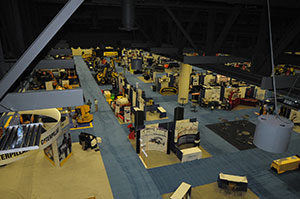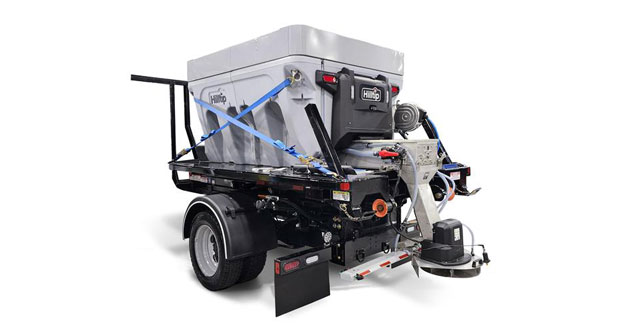Snow and ice management professionals studied up in June and July at several industry educational events.
When it heats up outside, savvy snow management professionals don’t neglect their winter work—they hit the books for next season.
This summer provided several educational opportunities, including the Snow & Ice Management Association’s (SIMA’s) Annual Snow & Ice Symposium, held June 20-22 in Minneapolis, and Sno-Motion, a seminar and roundtable event hosted by Pro-Motion Consulting in Cleveland, July 11-12.
It’s about trust
Snow & Ice Symposium keynote speaker David Horsager presented “The Trust Edge: 4 Keys to Create, Build and Enjoy Lasting Momentum.”

Why should snow and ice professionals care about a “soft” topic like trust? Consider the following statistics from the 2009 Edelman Trust Barometer. When people trust a company:
- 91 percent chose to buy from it;
- 76 percent recommend it to a friend;
- 55 percent will pay a premium; and
- 42 percent share positive experiences online.
“For the trusted brand, people pay more, come back and tell others,” Horsager said. “From the trusted salesperson, people buy. The trusted leader is followed. A lack of trust is your biggest expense, and it doesn’t matter if it’s with your spouse, a friend or a client.”
The pillars of trust, he explains, are the eight distinct qualities that build a competitive advantage when others confidently believe in you—it’s what Horsager calls “the trust edge.”
These pillars include: consistency, clarity, compassion, character, contribution, competence, connection and commitment. Mastering the pillars and gaining trust isn’t easy, because trust is always a risk, he said. Remember: “It’s the little things done consistently that make the biggest difference.”
Being a great employer
One well attended Symposium session was “Why Become a Great Employer?”—a talk given by Mike Rorie, CEO of GIS Dynamics and former CEO of Cincinnati-based GroundMasters, which he sold to Brickman in 2006.
At its peak, GroundMasters had 550 employees at eight locations. Becoming the landscape employer of choice in his market was a key to the company’s success, Rorie said.
The goal for any Green Industry company that wants to grow should be to become the place where people want to work—where competitors’ employees approach you and ask if there’s a place for them.
“If your name comes up as one of the best places to work, you’ve got a competitive edge,” he said.

So, how do you get there? Here are a few tips from Rorie.
- Share the company vision. It’s important to employees to have a road map of the organization’s goals and values to create buy-in. Remember, employee satisfaction equals customer loyalty. “People want to do business with employees who look like they love what they’re doing,” he said.
- Give your employees great systems. These may include software (financial, sales, management, measurement, etc.), checklists, manuals and processes with documentation. “Lack of systems causes confusion, frustration and chaos,” Rorie said. “Employees feel like they’re not in control. It’s your job to produce a solution so that doesn’t happen.”
- Work hard to retain the proper talent. When companies achieve a certain level of talent within the organization, senior managers and key team members become “gatekeepers”—wanting to have a say about who gets into the company, he said.
- Recognize, reward and replace. “It’s vital to recognize those who are exceeding expectations by improving the fastest or taking on more responsibility,” Rorie said, adding it’s important to follow up that recognition with rewards those employees value. Here are a few ideas:
- Offer personal recognition in front of peers;
- Send home a thank-you card; or
- Give them a perk or financial incentive such as a car wash, lunch, paid day off or 50-cent raise.
Finally, if managers or other employees say there’s someone on the team who doesn’t belong, listen to them. “There should be no sacred cows,” Rorie said. “Great employees appreciate when you hold everyone accountable. The best form of praise you can offer other team members is to replace the under performers.”
Objects in motion
Attendees at Sno-Motion were taken back to physics class by host Phil Harwood when he shared: “An object at rest will stay at rest and an object in motion will not change its velocity unless an external forces acts upon it. You are the force, if you take action!”
With that, Harwood, CEO of Pro-Motion Consulting, emphasized the interactive slant of the event, which featured product- and technology-focused sessions, including speakers and roundtable talks and group presentations. The format spurred much discussion.
Attendees shared many good ideas during the event. Here are just a few:
- Test run. When Harwood ran a snow and ice management firm, the company would do a “fire drill” before the season’s first true snowfall. When there was a dusting of snow, the company would bring all staff in, guarantee them four hours on the clock to make it worth their while and run them through all the procedures.
- Bonus round. To encourage employee retention and timeliness, Brian Vanhengstum of DICAM Landscaping in Binbrook, Ontario, shared that his company has had success offering a $2 per hour bonus for all hours worked at the end of the season to employees with 100 percent prompt attendance.
- Box it in. Neal Glatt, account executive at Case Snow Management in Attleboro Falls, Mass., said his company uses box trucks for sidewalk crews. They can hold and keep dry all of the necessary materials and tools, including brooms, blowers, shovels, etc. “That truck can take on sidewalks for any account,” he said.
- Call me, maybe. Bruce Vander Vennen from Jack’s Lawn Service & Snowplowing in Bryon Center, Mich., shared his tactic for keeping crew members informed during snow events: a text and voice broadcasting service called Call-Em-All. The service also accepts replies, which he receives via email.

